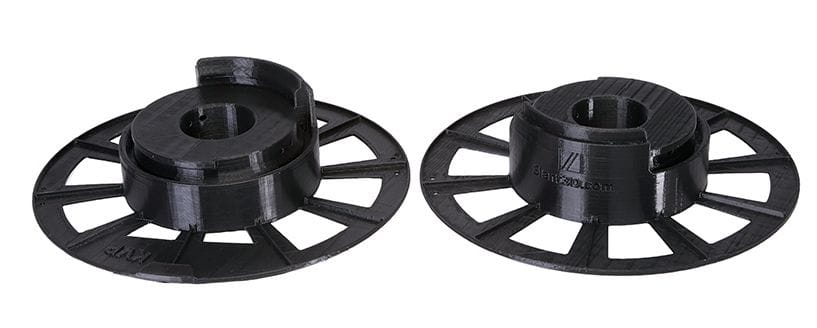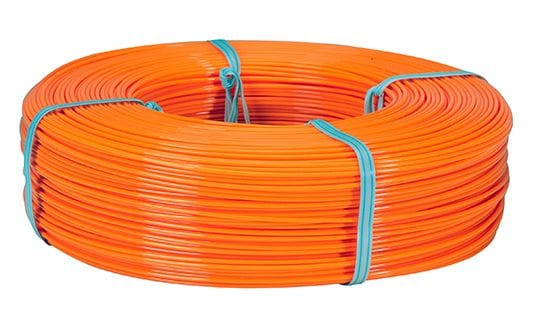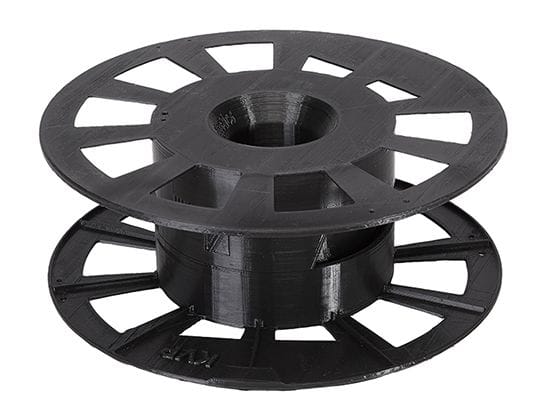
Keene Village Plastics, an Ohio-based 3D printer filament manufacturer, announced a reusable spool system they call “The Filament Koil”
The reusable spool idea has been around a while now, but as time passes the concept is becoming increasingly important. Why? Any busy 3D printer operator will tell you they have literally mountains of empty spools from various filament manufacturers. I myself pitched several dozen into the recycling bin the other week.
They are accumulated by 3D printer operators as fast as they can print the material. Once complete, the empty spools are essentially useless, except for radical art projects I suppose. But if you don’t happen to have hipsters dropping by looking for your spools, you will no doubt have tons of them. And unless you always buy the same brand and size, they will usually be of very different design, size, material and color.
The solution to this could be a universal spool holder. One proposal for this got significant press earlier this year, when 3D print enthusiast and Fabbaloo friend RichRap proposed what he termed the “MasterSpool”. The MasterSpool is two separable halves of a normal spool, allowing the operator to drop in a coil of unspooled filament and “spool” the material locally instead of at the factory.
There’s great merit in this idea, because it not only saves you the storage space for all those annoying empty spools, but also because the shipping costs are lower (less weight) and you end up with a spool that’s always the same size to fit your 3D printer mounting system. Costs should be less as you’re no longer paying for the spool.
While the MasterSpool concept has yet to take off – and our previous story suggested that such things require a critical mass of participants before they can catch on – another option has emerged from Keene Village Plastics.

Their new “Koil” concept is very similar to the MasterSpool: two halves of a spool that can be snapped together, with an associated product line of filament coils to fit on it.
Koil can handle 750g, 1000g and 5lb (2.3kg) coils of filament, and is distributed digitally! You can download the 3D model for the Koil and print as many as you’d like – but make sure you print both halves. If you don’t want to print a set, they can provide you with a pre-printed one via their manufacturing partner, Slant 3D.

Accordingly, Keene Village Plastics has simultaneously announced the availability of a number of their filament products in Koil-suitable unspooled coils. Currently they provide coils of PLA, ABS, P-PLA and soon PETG.
They’re selling the system directly as well as through several resellers, including Matterhackers, Dynamism, 3D Kustomz and Filaments.ca.
But is it actually less expensive? Let’s check out Keene Village Plastic’s pricing.
A standard 1kg, 1.75mm blue (our favorite color) spooled filament is priced at USD$39.
A Koil of 1kg, 1.75mm blue (still our fav) is priced at only USD$32! This is a savings of 18%, or USD$7 per kg. That’s significant.
However, that’s comparing Keene Village Plastic’s products to Keene Village Plastic’s products. Pricing of PLA filament in particular varies considerably among vendors and brands. Matterhackers, for example, sells the same Koil for only USD$29, and other brands may be even less expensive than the Koil – with a spool!
So it remains to be seen whether this will catch on. I hope it does, and civilization can avoid the thousands of unnecessary spools.

